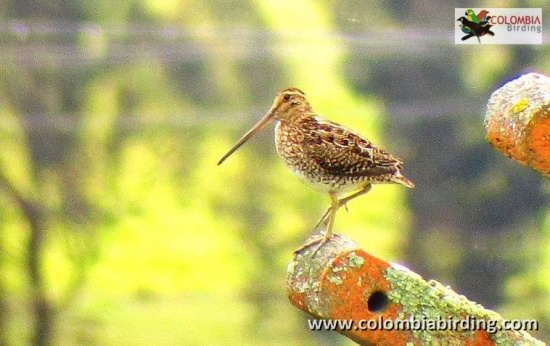m (→External Links: updated GSearch) |
|||
| (4 intermediate revisions by 2 users not shown) | |||
| Line 1: | Line 1: | ||
| + | [[Image:Noble_Snipe.jpg|thumb|550px|right|Photo by {{user|COLOMBIA+Birding|COLOMBIA Birding}}<br />Eastern Andes, [[Colombia]], June 2010]] | ||
;[[:Category:Gallinago|Gallinago]] nobilis | ;[[:Category:Gallinago|Gallinago]] nobilis | ||
| − | + | ||
==Identification== | ==Identification== | ||
| − | + | 30–33 cm | |
| + | *Dark brown and buff-streaked upperparts, head and neck | ||
| + | *Gold feather edges form lines along the back | ||
| + | *White belly | ||
| + | *Brown flank barring | ||
| + | *Horn-coloured bill is very long and straight | ||
| + | *Legs and feet are greyish-green | ||
| + | |||
| + | Sexes similar, but females have a longer bill<br /> | ||
| + | Immature birds have pale fringes on the wing [[Topography#General Anatomy|coverts]] | ||
==Distribution== | ==Distribution== | ||
| − | Andes of [[Colombia]] to | + | [[South America]]: found from the Andes of [[Colombia]] to south-western [[Venezuela]], [[Ecuador]], and northern [[Peru]]. |
==Taxonomy== | ==Taxonomy== | ||
| − | + | This is a [[Dictionary_M-S#M|monotypic]] species<sup>[[#References|[1]]]</sup>. | |
==Habitat== | ==Habitat== | ||
| − | + | Highland wet grassland marshes and swamps. | |
==Behaviour== | ==Behaviour== | ||
| − | + | ====Diet==== | |
| + | Their main diet consists of insects and worms foraged from deep mud. | ||
| + | ==References== | ||
| + | #{{Ref-Clements6thAug14}}#Handbook of the Birds of the World Alive (retrieved September 2014) | ||
| + | #Wikipedia | ||
| + | {{ref}} | ||
==External Links== | ==External Links== | ||
| − | {{GSearch|Gallinago | + | {{GSearch|"Gallinago nobilis" {{!}} "Noble Snipe"}} |
| + | {{GS-checked}}1 | ||
| + | <br /> | ||
| + | <br /> | ||
| + | |||
[[Category:Birds]] [[Category:Gallinago]] | [[Category:Birds]] [[Category:Gallinago]] | ||
Latest revision as of 10:49, 31 May 2023
- Gallinago nobilis
Identification
30–33 cm
- Dark brown and buff-streaked upperparts, head and neck
- Gold feather edges form lines along the back
- White belly
- Brown flank barring
- Horn-coloured bill is very long and straight
- Legs and feet are greyish-green
Sexes similar, but females have a longer bill
Immature birds have pale fringes on the wing coverts
Distribution
South America: found from the Andes of Colombia to south-western Venezuela, Ecuador, and northern Peru.
Taxonomy
This is a monotypic species[1].
Habitat
Highland wet grassland marshes and swamps.
Behaviour
Diet
Their main diet consists of insects and worms foraged from deep mud.
References
- Clements, J. F., T. S. Schulenberg, M. J. Iliff, D. Roberson, T. A. Fredericks, B. L. Sullivan, and C. L. Wood. 2014. The eBird/Clements checklist of birds of the world: Version 6.9., with updates to August 2014. Downloaded from http://www.birds.cornell.edu/clementschecklist/download/
- Handbook of the Birds of the World Alive (retrieved September 2014)
- Wikipedia
Recommended Citation
- BirdForum Opus contributors. (2024) Noble Snipe. In: BirdForum, the forum for wild birds and birding. Retrieved 11 May 2024 from https://www.birdforum.net/opus/Noble_Snipe
External Links
GSearch checked for 2020 platform.1




